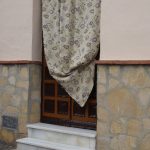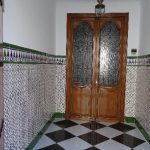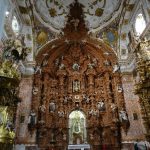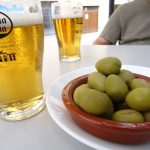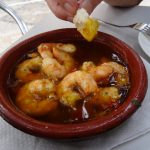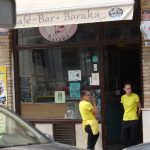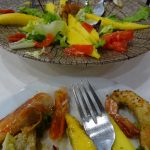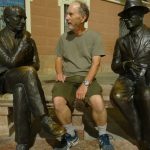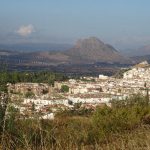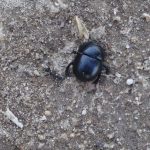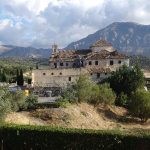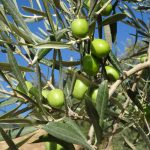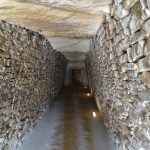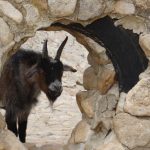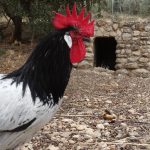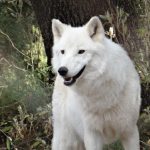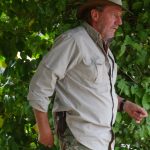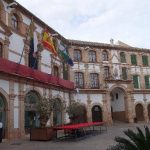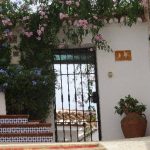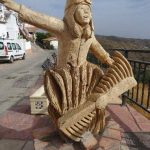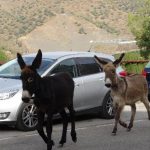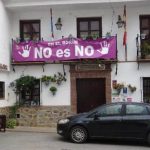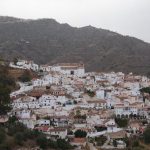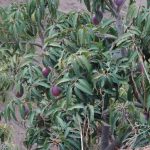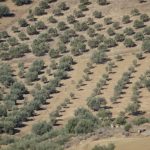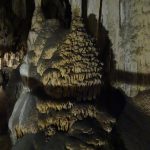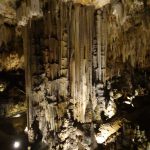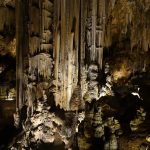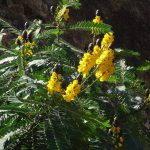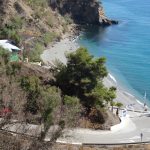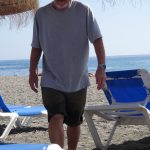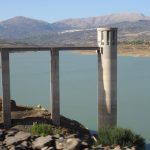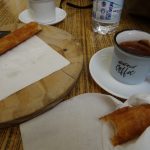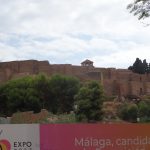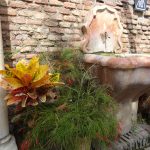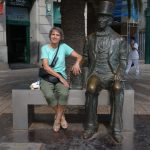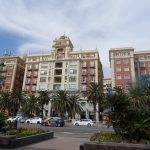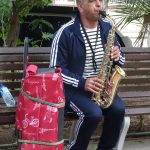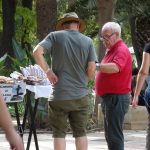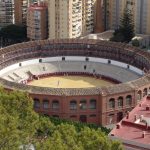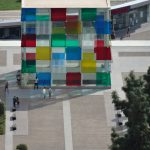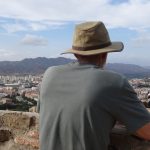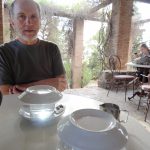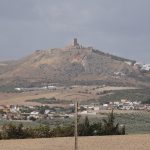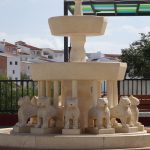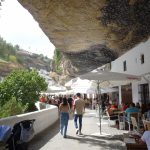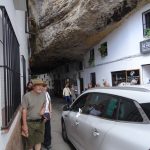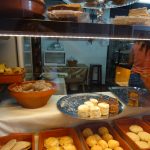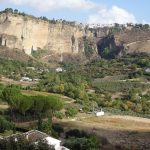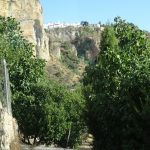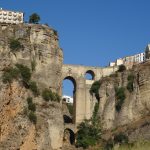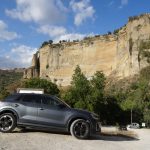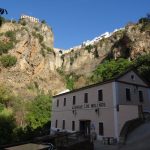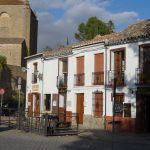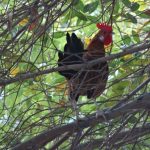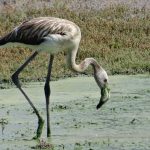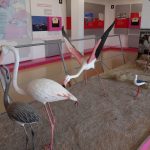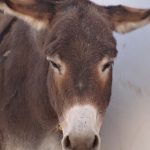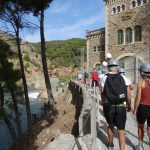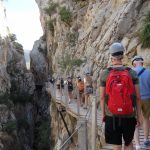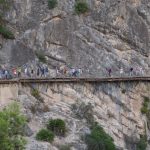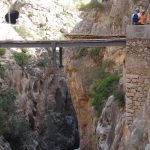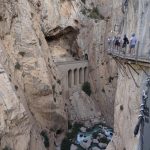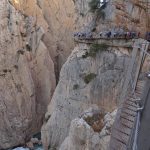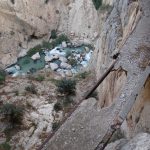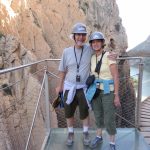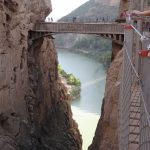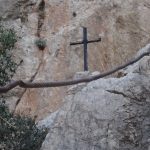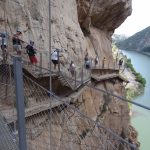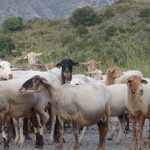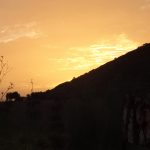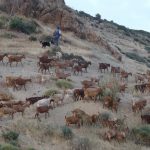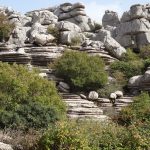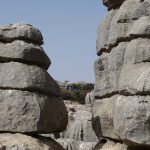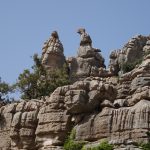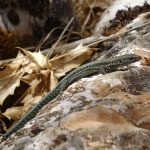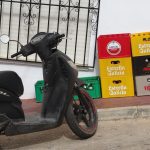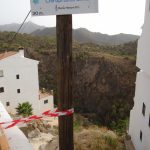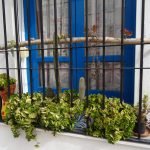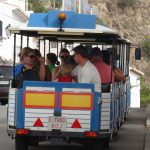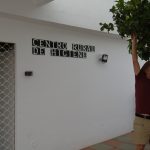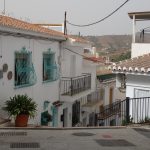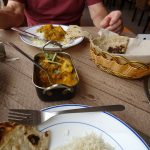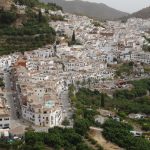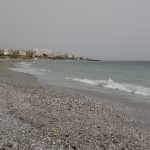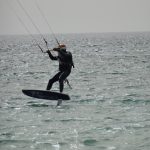-
A Farewell to Antequera
Olive Oil:
With olive trees as far as the eye can see in every direction it occurred to me – just how much olive oil does Spain produce? 50% of the world’s olive oil and over three times as much as Italy, Greece or Tunisia. That means that one out of every two bottles of oil sold in the world contains the Spanish product! There are more than 250 million olive trees throughout the country, Andalucía grows 75% of them – mainly in the Granada, Malaga and Cordoba regions – with Jaén considered the World’s capital. It’s doubtful harvesting is done the old fashioned way any more – beating the trees with sticks to loosen the fruit into waiting nets. Now they have machines which enfold the tree with something rather like an upside down umbrella and then pneumatically vibrate the fruit loose. Still labour-intensive though. I believe some places use low-flying helicopters to shake the trees.Hidden Entrances:
Behind every stout, no-nonsense door (or cloth curtain) along every street, lies a hidden gem . . . beautifully tiled entry ways … each using a different colour and pattern. Some go for the plain and simple look with perhaps a potted plant or two … others are more elaborate or striking in appearance, often with ornate, wrought-iron gates leading into the house instead of just wood.All doorways also have an indispensable heavy cloth curtain. First thing in the morning, the outer doors are opened, doorsteps are swept and washed, and curtains are pulled across – the perfect answer for both ventilation and privacy, while still having a friendly, approachable attitude should the neighbours want to stop by. Let me tell you, by the end of the first week I too was washing the front doorstep … I certainly didn’t want the local senoras tutting and rolling their eyes as they went past.
Starlings:
As dusk descends, flocks of Spotless Starlings gather to roost in the big, cloud-like pines around the square. The volume of sound is indescribable … a melodious symphony of whistles, flutes and trills … you can hear them as you drive by – with the windows up! I’d never even heard of Spotless Starlings before now, but like all starlings they are clever mimics and have a diverse repertoire. The city has wisely removed park benches from under the trees!Iglesia del Carmen:
There are multiple churches and convents throughout Antequera, but the Church of Carmen is a particularly lovely one. Not much to look at on the outside … inside there are the usual niches decorated in gold, commemorating various saints, however it is the intricately carved nave and altar that are quite remarkable.
The Museum of the city of Antequera was a hidden gem. Spread over three floors it contained a staggering display of the history of the area — this stuff is truly UNESCO quality. Pottery, frescos, jewellry, paintings, grave sites. Completely unexpected.
La Comida:
Before leaving Antequera we knew we’d have to visit two places. One we had walked past so many times … Cafe Baraka . . . tables and chairs under the spreading shade of an unknown tree across the street. Food is dashed across from the kitchen by nimble-footed servers. We had a very civilized late lunch, watching the world go by . . . a dish of green olives and two small cervesas to start, followed by sizzlingly hot lagostinas (large prawns) in spicy olive oil with bread for dipping. Oh my!
Our last evening was saved for Meson Adarve (if you Google Meson Adarve, Antequera, and then click on the ‘menu’ there are photos of the food) … a family-run restaurant. Only a handful of tables, so reservations were a must. We stopped by that afternoon to inquire … there was an intake of breath and pursing of lips as Juan contemplated his phone and counted that night’s bookings. A pause, and then “Sí, una mesa para dos” … YES, we were in for 8:30.
We walked through the busy, lit streets for the last time … dodging scooters and stepping into doorways to avoid cars. There were no menus … all dishes were written on blackboards on the walls … verduras (vegetables), carnes (meats) and pescados (fish). We settled on a mango and prawn salad with Rabos de toro (oxtail stew) to follow. The local mangos are something special – perhaps it’s because they are allowed to ripen on the trees, or the flavour is different, whatever the case, these were exceptional … and in combination with the prawns, mix of greens and subtle dressing – this was a dish NOT to be missed. Then the Rabo … slowly cooked for hours till it was fall-off-the-bone tender in its own gravy … served with the traditional crisply golden potato chips. Thank goodness there was bread for mopping … it would be a sin to miss any of that sauce.
There was no room for dessert … not even a shared cheesecake … but the son brought us tiny glasses of chilled licor de limón as a digestif. Very pleasant. A message from the restaurant states that nothing is ultraprocessed or precooked – here you eat as God gave/provided.
For some glorious photos of places round Antequera do have a look at this site:
Guide To Antequera, Best Things To Do In The “Florence of Andalusia”
Hidden Entrances Each tiled entrance is different Iglesia del Carmen From the museum From the museum From the museum Olives with everything – yum Sizzling Lagostinas Servers on a break Mango & Prawn Salad Evening chat with neighbours -
Dung Beetles, Dolmens and Lobos
There’s a lovely hiking trail in the hills overlooking Antequera – almost four kilometers of relatively flat, rock-strewn sandy path. It meanders its way past the remains of 17 Roman Arquillas – a system which carried water into town, while providing stunning views over the town and Peña de los Enamorados one way … tree-covered hills, farms and a
golf course (!) the other. The brilliant green of the fairways look totally out of place in an otherwise arid-looking landscape, but at least they have built two large reservoirs/rain catchment areas for watering the grass. The morning’s cloudburst must have done wonders in replenishing them. There were still a couple of puddles along the trail, but the sandy soil had sucked up the moisture almost immediately. Curious patches of black, polka-dot holes edged the path every few steps … a closer look revealed busy colonies of ants, industriously clearing out their underground tunnels after the deluge. No anthills visible … just a scattering of small, black holes like openings in a pepperpot. Careful where you stand when taking photos – the much larger guard ants had particularly large pincers … and held them aloft, menacingly!
Further along, a glossy black beetle – totally impervious to the ant currently investigating its leg – trundled along like an armoured tank. Is that …? Yes … it IS a dung beetle! We used to see lots of them in the dunes along the coast, rolling balls of dung three or four times their size … the spheres looking for all the world like sugar=coated chocolate truffles! Occasionally, they’d lose control of their prize, and have to cling on tightly as they both rolled to the bottom of the dip … necessitating another uphill climb. Well, there was plenty of ‘dung’ at the beginning of the trail — it seems people bring their BIG dogs up here for walks! Great video: https://youtu.be/I1RHmSm36aE
At the end of the trail is a former convent – now turned posh hotel and restaurant – Hotel Magdalena. And what a glorious locale. Gardens filled with banks of flowering rosemary – smelling wonderfully resinous when brushed against. Mauve and Magenta bougainvillea draped – oh so casually – over rock walls, bushes of pink and white Oleander lined the driveway, olive trees laden with ripening bright green olives and the distant valleys and smoke-gray mountains provided the perfect backdrop.
A twenty minute walk from where we’re staying, and just on the edge of town, are two of the Dolmens. Ancient underground monuments – the earliest dating back 5000-6000 years and consisting of gigantic slabs making up the walls and roof. The cut edges are remarkably precise and It’s hard to imagine how those massive roof slabs could be moved into place. It was only after visiting the Antequera museum that we found out the secret … they lay the roof pieces on the ground first and then excavated the cavern underneath … reinforcing with vertical pillars as
they went. Very clever. https://www.andalucia.org/en/antequera-cultural-tourism-dolmen-de-menga These two dolmens are aligned in some way with the mountain La Peña Enamorada – especially during the summer and winter solstices . . . there is a large sundial for just this purpose.
At the interpretation centre, a photo panorama took up an entire wall, however two middle-aged couples hogged the whole display. Pictures were taken of one wife … facing this way … then the other … with arms outstretched … standing in the centre. Repeated with the other wife . . . then one couple together . . . and t’other. ARGHHHH . . . how many photos of this were they actually going to look at when they got home!! People walked out in disgust, but it didn’t make any impression with these four. We left them to it and enjoyed the monuments.
The Roman era Dolman is considerably younger – a mere 2,000 years old, and set some distance away from the others. The construction is vastly different though – small clay bricks create the entrance tunnel and circular, domed roof. Significantly easier to construct, I would imagine.
Los Lobos Park sits at the foot of El Torcal. https://www.lobopark.com/ Only open from Thursday to
Sunday, the tours have to be booked ahead and each is just over an hour long. The co-owner, Daniel, worked for many years studying dogs and training them for police and military services, but about 20 years ago he became interested in creating a specialized park where Tundra, Timber and the endangered Iberian wolves could establish packs and live out their lives in as normal a setting as possible. Iberian wolves have been hunted to extinction here in Andalucia and only exist in the wild in northern Spain. The park has accepted wolves from zoos all over the EU . . . in fact a new female Tundra wolf had just arrived . . . and two more were in transit from the Ukraine – stuck in Madrid due to red tape bureaucracy. Once wolves reach adolescence at about two and a half, if they are not already in a pack, they cannot be introduced, or re-introduced to one … a new pack would have to be established. . . sometimes just females or in one case ‘the bachelor brothers’.
The park also takes in other abandoned or homeless critters like pot-bellied pigs, goats and chickens.
The current 28 wolves are comfortable with humans around their (huge) enclosures, but are in no way tamed. The original pups were hand reared by Daniel, but once they were adults and had formed a pack he stepped back and left them to do what wolves do in the wild. One of the guests asked if they ever howled … and Daniel obliged by walking over to the bachelor enclosure, and howled … the five wolves inside rushed up and howled along … pretty soon there were responses from all over the acreage. Enough to give you goosebumps.
Antequera & La Pena Dung Beetle Hotel Magdalena Olives ripening Roman Dolmen Dolmens – moving the roof slab Peek-a-boo Tundra Wolf Iberian Wolf Timber Wolf Daniel aka Crocodile Dundee -
Turkeys, Burros and Blueberry Cheesecake
Jabbing a finger on the map and then taking whatever road led to a tiny village is pretty much guaranteed to delight every sense. Not far from Antequera is Archidona – famous for its international film festival which has promoted cultural diversity since 2004. The town has an unusual and striking octagonal plaza, part of which was being used as an outdoor cafe. An enormous edifice which used to be a library but now houses the high school sat squarely in the middle of town. There is a plaque on the wall that mentions the famous poet Miguel Cervantes and commemorates the 400th anniversary of the publication of Don Quixote. Interestingly, Cervantes conducted his own ‘Quixotic’ journey around Andalucia … but as a tax collector for the government!
La Joya a track takes you up, way up to the Hotel la Fuente del Sol with commanding views of the valley far below. It’s a four star hotel and restaurant out in the middle of nowhere, surrounded by glorious and immaculate gardens … and a flock of turkeys wandering happily through the bushes … gobbling conversationally as we approached. A señora was just getting into her car and explained that they were closed for the next two days – probably the usual Monday/Tuesday closing. But she urged us to come back and try the excelente locally grown and prepared regional food.
On another outing a double archway framed the entrance to the village of Moclinejo high on its mountain perch. A photographer’s dream, as literally every house, window, garden, and set of stairs cried out to have its photo taken. By now we were reasonably adept at squeezing down cramped, cobblestone passages, but not here I’m afraid – we’d met our match. Around one corner there was a sudden intake of breath as we met an oncoming car on a steep, inclined hill, and no easy way of backing up. Obviously the other driver was local and probably well used to incompetent tourists visiting his town . . . he graciously backed up into a corner the size of a postage stamp, and waited for us to pass. Best thing was to park and walk … so we did. Past the Iglesia de Nuestra Señora de Gracia with a cat sunning itself outside – blue pots bright against the dazzling white walls … a window crammed full of plants and succulents … colourfully tiled stairs leading to doorways draped in wisteria, hibiscus and bougainvillea. Near a lookout stood a carved wooden statue to Pablo Benthem Martín-Alonso, 1966-2019 who appeared to be an adoptive son of the village … and someone who seemed to have done practically everything – adventurer, diver, member of an expedition traveling through north and south Africa by autogyro – as an homage to its inventor, Juan de la Cierva. Pablo became involved in the history and traditions of the village, and as such this memorial was created in his honor. I just love the last words of the plaque … “above all, there are always your neighbours, your family, so that where you are in the sky, the soft breezes and wind will tuck you (hold you/protect you?) in every flight”. This was worthy of further investigation so here (if you click on the English translation, upper right) you can read a bit more about this adventurer. https://www.laopiniondemalaga.es/municipios/2019/02/25/moclinejo-declara-dia-luto-muerte-27828997.html
On our way back to the car, a clip-clop of hooves materialized into a young lad leading four burros down the road towards us. The two older ones were haltered, but the two youngsters trotted along behind. I called out asking if I could take their photo . . . and as they came level the two young ones slowed and eagerly approached, ears perked . . . however they were quickly “hushed” and “clicked” back in line to continue their journey. There was a clatter and buck of hooves in protest, before they all disappeared round the corner.
Another stop El Borge … even more dizzying views below … and another distinctive archway into town. The cobblestone patterns and designs differ from one place to another, too. Rounding the church, we found ourselves in an open plaza with what looked like a flight of stairs in front and a wall to the right. As we pondered the situation a jovial señor detached himself from his compañeros at the outdoor cafe and approached with a grin. No doubt we were not the first to encounter this conundrum. We gleaned enough to figure that the road did in fact continue beyond the wall – with equally good views, apparently … or if preferred we could go back out the way we came. Of course an animated but good-natured discussion ensued as all the cafe patrons weighed in over the pros and cons of which way was best – lots of friendly jibes and laughter. In the end, we parked the car and after an amble around town, returned to the plaza for tea.
An elderly señor sat on a bench beside the entrance, hands clasped atop his cane – no doubt his usual spot. We nodded and wished him buenas tardes … he replied with a tooth-challenged smile. In our best Spanish we began to order at the counter, but the owner was having none of it. She wanted to show off her English … and to be honest it far exceeded our attempts. She insisted we try her blueberry cheesecake . . . or even better the carrot cake . . .. no, no, by far the best was the chocolate everything (she struggled to find the right words) “chocolate to die from!” she exclaimed triumphantly. And was probably right – calorie-wise.
A game of dominoes at a nearby table had just ended and there was a loud clackety-clack as the tiles were vigorously shuffled. As is customary here, tea is drunk from small glasses – often with hot water and tea bag on the side. If milk is required it is usually heated and brought in a small metal jug. However this time there were tiny teapots in which to steep the tea . . . but the piece de resistance was the cheesecake … light and creamy with a layer of tangy pureed fruit jelly, fresh blueberries, swirls of whipped cream and wafers on the top. Decadent, sinful but deliciously wonderful. Every mouthful was savoured in its entirety. The server confided to us that it was only his second day on the job, and that the owner was actually his ex wife. And that’s Vale? (OK) we asked, a bit hesitantly. He quite cheerfully replied it was perfectly fine. We’d now had dessert … but I don’t think we’ll be needing much dinner tonight. As we got up to leave, the owner reminded us to come back and try the ‘chocolate bomb’ … and everyone at the nearby table called out adios or viaja con cuidado (travel carefully). Quite often in small towns there’s a certain ‘reserve’ around strangers – at least until overtures have been made . . . but not here. They were openly welcoming from the get go.
On the trip home, there was the damp, earthy smell of rain in the air … although it didn’t amount to much. Just a few sprinkles. It took an age to loop our way down into the valley. All the mountainsides are tightly terraced – with slopes of 45 degrees, or more and cultivated with either citrus or mango trees. Some terraces have horizontal sheets of galvanized corrugated metal as retaining walls, and it’s quite something to see the rows of glinting silver all the way down. I can’t imagine how uncomfortable and difficult it would be to work on these steeply angled fields. As we neared Antequera the cap of clouds lifted just enough to let the sun peek under and give everything a golden glow.
Octagonal Plaza, Archidona Turkeys at La Joya Garden Gate, Moclinejo Pablo the Explorer Two young burros Blueberry Cheesecake extraordinaire El Borge -
Nerja Revisited
The caves at Nerja came highly recommended as a place NOT to miss (thank you Sue) so, rather than taking the usual A45 highway into Malaga, we plotted a back route via the 7204 and A356 through the hills, villages and valleys … past hillsides draped in the ever-present olive trees, their shadows in the morning sun making them look like knobbly green bedspreads … and down into Vélez-Málaga before connecting with the N340 along the coast. A much more scenic route … and it avoided busy Malaga. The area around Vélez-Málaga is ALL citrus trees … nary an olive to be seen.
We’d packed sandwiches for lunch, planning to find a park or a vacant bit of beach to eat them – no such luck. Nerja is an attractive but holiday-based town, and busy – so not many parking places anywhere near the waterfront. We did, however, find a very pleasant tree-lined gravel parking lot on one of the side streets, and munched our food in the shade while birds chirped in the branches above.
Taking the coast road, the caves were just 5 minutes north in Maro, and we almost had the place to ourselves. https://www.visit-andalucia.com/guide-to-nerja-caves/ Discovered in 1959 by some teenagers looking for bats while on an evening hike, these caves are jaw-droppingly awesome and I defy anyone to find an adequate description. We stood as insignificant tiny dots in the hushed, dimly lit vastness of a cavern that dwarfed most cathedrals … the staggering number, size and GIRTH of the calcified stalactites and stalagmites … and sometimes you don’t know which because they meet and reach floor to roof. Solid limestone waterfalls … pillars … arches … chandeliers …spires … all frozen in eons of time. Surely Gaudi must have visited such a place to gain inspiration for his Sagrada Familia . . . the resemblances are remarkable. However this cave was discovered much later than Gaudi’s time. It is reputed to contain the largest stalactite in the world. If you get a chance, DO visit.
A little north of the pretty and unspoiled pueblo of Maro, a cliff road wound down to a protected sandy cove. We joined the line of parked cars parked along the steep verge and ambled down. It was longer and steeper than it looked. A sprinkling of people lounged on rented sunbeds under grass umbrellas, or had brought their own sunshades and beach blankets . . . there were a few colourful kayaks for rent . . . kids were swimming, and an occasional snorkeler drifted by. This was far removed from the noise and bustle of more popular Costa beaches. We sat in the shade and enjoyed the ambiance for a couple of hours. Glen, feeling the need to at least paddle his toes in the Mediterranean, rolled up his shorts a bit and cautiously padded over the hot, pebbly sand. All was fine, until a slightly larger wave rose higher than expected and soaked the lower half of his shorts. Nothing a walk along the beach and a lounge in the sun couldn’t handle.
We thought we had found yet another way home via back roads . . . it certainly was scenic, but it meandered further and further from the direction we wanted . . . then the gas gauge took a sudden plunge and the warning light came on. Hmmm … didn’t we we pass a gas station back there a bit? It had looked closed and deserted – an Agri-coop … wonder if that means it only has farm gasoline? … but no – there was the sign for gasolina 95 sin plomo. This, however, was quite unlike any usual gas/petrol station . . . consisting of a shiny metal cubical with pump-handles both sides, and completely automated – you paid ahead using a computerized screen (thankfully, language of choice could be selected) . . . AND it was about €0.15/litre cheaper than in town.
We ended up going back the way we came, but this time were able to get a better view of the dam and reservoir – Embalse de la Viñuela … this is the first time we’ve seen the extent of the drought this summer. Levels in the reservoir resemble those in California with ‘tide marks’ getting progressively lower and lower … the pumps now barely reaching what’s left of the lake. We’d just driven past lots for sale … advertising water-front property … that now isn’t. It’s sad to see, but a relief that the olives and orange trees are thriving though.
Olives and Shadows Cueva at Nerja Cave formations Beautiful – but don’t know the name Secluded beach at Maro just outside Nerja So much for just paddling! Embalse de la Vinuela, reservoir -
Malaga’s Old Town
We’re off to Malaga! It’s National Day in Spain – a contentious subject in some parts as this is the day Christopher Columbus (Cristóbal Colón) ‘discovered’ the Americas. Known in some places as Columbus Day, others have changed it to reflect a more inclusive or indigenous nature. Mostly, people are just glad of a holiday.
The modern downtown area was avoided with surprising ease – and we drove along the waterfront on wide boulevards to the old section. Cool shaded parks, meandering walkways, playgrounds, fountains and statues were there for people to enjoy. Two cruise ships were docked … one smaller, one huge. Not a lot of passengers immediately visible.
There was a parking lot right beside the Alcazaba – how handy is that? After a couple of futile tours around the first parking level… with cars stalking returning pedestrians, or disgorging all passengers before attempting impossibly tight parking maneuvers into the skinniest of spots . . . we descended a floor. Why … there’s tons of empty spots down here … we’re spoiled for choice!
Two cups of dense hot chocolate and a plate of piping hot, freshly cooked churros were the perfect energy snack. The churros were excellent dipped in chocolate or sprinkled with sugar (however my favourite’s still with sugar).
The Roman amphitheater is a mere two minute walk across the road and through crowded plaza lined with overflowing food establishments and hawkers selling the usual hats, trinkets and paintings. Online, you can see tickets for the Roman ruins being sold for 30 euros . . . but one can walk past and view all you like, for free!
We splurged, and got seniors passes for both the Alcazaba and the Castillo de Gibralfaro .. a bargain at 2.5 euros each. Then we walked up through the slippery, well-worn cobblestones, through a Moorish arch and into a rocky walled garden dripping with palm trees, cactus, philodendrons – with leaves the size of umbrellas. This Alcazaba felt warm, intimate and inviting … quite different from the one in Cordoba. Around every corner and archway – surprise gardens, mosaic-tiled ceilings, reflective pools, a restful bench.
Then for a change, we followed the busy thoroughfare past the distinctive building which years ago had been a hotel we stayed in (now a bank and private apartments) – there’s a statue of Hans Christian Anderson outside.
Crossing the road, it was a relief to enter the cool interior of the park. Here families or couples strolled enjoying a leisurely afternoon … a kiosk with roasting chestnuts . . . musicians serenading. One in particular – a saxophonist – halted us in our tracks with a glorious and haunting rendition of an Andrea Bocelli piece — Con te Partiro. Soon he had an appreciative audience who spontaneously applauded and cheered as he finished – and contributing to his earnings in the process.
There was a rude awakening along the harbour front however. An onslaught of commercialism … Burger King, McDonalds, Hard Rock Cafe, Duncan Donuts . . . expensive shoe and handbag stores . . . restaurants packed cheek by jowl – beckoning you to ‘try a taste of Spain’ … ‘Authentic Paella’ … ‘Tapas, only one euro’ (crisps/potato chips on a plate – I kid you not!). The lighthouse was worth a picture, but we hot-footed it back to the serenity of the park.
Roasted almonds in paper cones – the cart owner was chatting to a friend, but keeping a wary eye on the wily pigeons who edged ever closer. Suddenly, with a roar and great flapping of arms he dispersed the flock . . . but only temporarily. They gradually melted back. And who could blame them – the roasted almonds were delicious. Different in shape and flavour from those in California. Flatter, more rounded.
We could put off the hill climb no longer. Thankfully, a couple of weeks training on Antequera’s streets have prepared us, but it was still a haul to the top. Worth it for the magnificent views though. The whole of Malaga lay spread out before you like a map . . . the bull ring … harbour … lighthouse… city … and coastline. Afterwards, a cup of tea under the wisteria pergola didn’t go amiss
Neither of us felt like going out for dinner when we got home … so we raided the fridge and constructed a kitchen sink omelet … bursting with onions, peppers, tomatoes, chunks of local chorizo and topped with Manchego cheese. One of these days we will have to find a place that does a really good, authentic paella. I made a version of one the other day with saffron from Malaga – not bad … and even better as leftovers with added prawns. But we still want to try the real thing.
Churros & Chocolate Alcazaba in Malaga Water feature, Alcazaba Jenny meets Hans Christian Anderson Old Hotel, now a bank and apartments Saxaphone in the Park Roasted almods for sale Malaga’s bullring Glass wall View from Gibralfaro – castle above the Alcazaba Much needed tea and a rest after the climb -
Castles, Caves and Ronda
Showers have been predicted over the next couple of days, so this morning’s clear skies enticed us to go exploring. Towards Ronda, perhaps? The huge wind turbines were spinning a bit faster today as we left Antequera behind – some of these giants are truly monstrous … dwarfing everything in sight. The gray-green of the olive leaves flickering to silver in the morning light. High on a hilltop a square-towered castle overlooked its tumble of white houses. The village of Teba … and Castillo de Estrella (Star Castle). Pretty and neat … a community piscina (swimming pool) and even a copy of Granada’s Lion fountain!
Next stop – Sentinel de las Bodegas, where parts of the town have been built into and under the cliffs. https://en.wikipedia.org/wiki/Setenil_de_las_Bodegas Shops, restaurants, garages . . . even a stable with horses! Parking was definitely at a premium, and we were fortunate to grab a spot halfway up the hillside, just as someone was leaving. The bars and eateries were doing a roaring trade … but fare consisted mostly of either locally cured meat, or specialty pastries of the region. People, cars and scooters vied for passageway in the narrow back streets and under the overhanging cliffs … so we took our pictures, and left … or tried to. The main thoroughfare was blocked with tour buses disgorging even MORE visitors. We waited patiently for an opening, and beat a hasty retreat. It seems Sundays are popular tour days for convoys of coaches doing the rounds of local interest spots.
Sign posts and Google maps disagreed on the actual distance to Ronda . . . was it 2.5 kms … 12 or 20? Perhaps one was as the crow flies? Nevermind, it was close by. Entering the city from one direction, Ronda looks like any other city, but it was the iconic ancient arches, bridge and sheer cliffs on the other side – that was ‘The View’ we wanted. Details were punched into Miss Google, and we eagerly awaited for a route to appear . . . surely that can’t be right? It looks no more than a cart track … and on the wrong side of town. We tried again, with similar results. An actual street map and road signs initially looked hopeful, until all road signage vanished into thin air. Exasperated, Glen decided to trust in his internal GPS and located a promising-looking lane leading in the right direction. Apparently, no ‘regular’ road takes you there … and this one certainly couldn’t be referred to as regular.. GASP! Sudden application of brakes as the lane ended in a sheer drop-off … and an unbelievable view of Ronda across the valley, towering on its massive bluffs. What a sight! But how to get there? That tiny, pot-holed, almost vertical ribbon couldn’t possibly go through, could it? And narrow … did I mention it was narrow? Barely wide enough for one car – with rock walls and fences on either side – what if we meet another vehicle? Expecting at any minute to arrive in someone’s private driveway, on we went, over cobblestones … past well-kept farms, haciendas, horse training establishments – is this the only access for these residents, too? What about farm vehicles? Over a stone bridge and under an avenue of shady olives … there were a couple of cars, but everyone squeaked through unscathed. And then, there we were … at the base of the bluffs … looking straight up at those arches, and the white buildings high above, like icing on a Christmas cake. Such an astounding view, one could only stand and stare. A smattering of people had hiked in … others could be seen as tiny specks on the viewing deck way up there.
Reluctantly leaving that jaw-dropping view – it’s like something out of a Cervantes novel – the car scrambled its way up the loose gravel and back onto the narrow but paved streets of Ronda. Up until now, we had been fortunate to encounter only the polite and courteous Spanish driver – unlike the current testosterone-charged idiot in his gleaming black sports car who jostled impatiently mere inches from our back bumper. We decided to let him pass by ducking down a convenient side street, intending to drive around the block and rejoin the road further on. Despite Glen’s finely honed diving skills (acquired from weeks of squeezing through impossibly tight lanes and alleyways) the sharp 90 degree turn at the end, combined with overhanging walls and hefty bollards ground us to a halt. Only scooters or tiniest of cars could have made that corner. A kindly resident just returning home, saw our predicament, and came over to help . . . the whole process conducted entirely in Spanish. Atras (back) … a bang on the roof to stop … Adelante (forward) … bang! Izquierda un poco (left a little) … bang! Inch by inch the car was straightened up. Ahora, de regreso (now, straight back). Profuse thanks to our rescuer, who smiled and waved us on. Relieved, we drove back through the older, much nicer part of town … a plaza and playground with children playing – the surrounding tavernas and cafes quiet in the golden light of late afternoon. Further on, the picturesque village of Cuevas del Becerro (Calf Caves) and a delightful community park created along a stream and duck pond. A walkway with orange trees – the green fruit just beginning to ripen – and some chickens wandering freely through the undergrowth before flapping, ungainly, into branches above to roost.
Teba & Castillo d’Estrella Mini Lion fountain Shops under the overhang Sentinel de las Bodegas Sudden drop off overlooking The Valley Road no more than a goat track Worth the white knuckles for THAT view Shame the restaurant was closed Part of old town Ronda Castle walls Roosting chickens -
Donkeys, Flamingos and Mountain Trails
A short drive from town, in the direction of Malaga, is the small town of Fuente de Piedra … best known for its lake – Laguna – where each year tens of thousands of flamingos come to nest.
https://andaluciainmypocket.com/fuente-de-piedra-where-to-see-pink-flamingos-in-spain/ These Greater Flamingos don’t turn entirely pink (like those in the Caribbean – or lawn ornaments) however their white, pink and black plumage is striking and beautiful. Normally, by this late in the season, the flocks (a flamboyance!) would have flown south to Africa but as this is the largest natural lagoon in Spain, and an important migratory stop-over for other birds, we took a chance there’d be other birds to see. In the Spring and Fall, rain fills this flat, marshy area into an enormous (but shallow) semi-salt lake, however after this summer’s never-ending series of heatwaves, the lake bed was completely arid and bleached. The marshy area along the main drive still contained brackish-looking water rimmed with a layer of green algae, reeds and scrubby trees. A thin strip of water was visible in the distance – so perhaps a bit deeper? Wait … was that …? “Quick … Stop The Car. Look!” And there, calmly feeding in the murky water right beside the driveway, were THREE flamingos. Not flamboyant, I’ll grant you, but we’ll take them. Leaning against a handy fence, we watched as they slowly paced on their long legs, huge curved beaks upended in the water … filtering the tiny crustaceans that sustain them. Quite magical.
At the Visitor’s Centre … not exactly brimming over with visitors, as you can imagine (two guides were sitting on the shaded front steps, chatting to a delivery driver) … however there was an excellent presentation of information, models, photos … and one wall entirely of glass, overlooking the lagoon. To see the lake covered with these majestic birds would be an experience indeed.
Just down the road is a Donkey Sanctuary – El Refugio del Burritos. Connected to the UK charity for rescuing injured and abused Burros – it houses around a 100 individuals. Disappointingly, the facility is closed temporarily – although a couple of burros peered sleepily at us though half-closed eyes. Perhaps the refuge will reopen before we leave. This video on YouTube (although all in Spanish) gives you an idea of the area around Antequera. https://www.youtube.com/user/elrefugiovideos
One of the must do excursions while in Antequera is the Caminito del Rey – the King’s Little Walk. https:///en/hiking-trails/caminito-del-rey-hiking-in-spain/
Once known as one of the most dangerous walks in the world, with its narrow, crumbling paths barely clinging to sheer rock walls – parts of it missing completely, and giving full view of the Guadalhorce river thundering through a chasm 100 meters below. There are horrifying videos on youtube of people doing just that, and after several fatalities, it was closed.
The original project started in the early 1900s so that workers and supplies could be brought in to maintain the dam, it was officially opened in 1921 by King Alfonso. It’s hard to believe that in the original construction, only two workers lost their lives … and one of those through carelessness – he took a smoke break beside some explosives! Families lived in the area right up until the 1970s, and children would daily walk the path into El Chorro to attend school. The walkway fell into disrepair and over the years, some 600 people have succumbed … the last in 2000 when a group of friends (after a night of considerable drinking) decided to use one of the steel cables crossing the gorge as a zipline … 3 at the same time. It couldn’t support their weight. Only the one with vertigo, who had refused the challenge, survived to notify authorities. There’s a metal cross on the wall above. Local government planned to dynamite and seal both ends of the Caminita trail, but it was deemed too important a landmark. Restoration finally took place, and it was reopened to the public in 2015. Must admit it was reassuring to see that every single fixture, cable and fastener was made from stainless steel – even the mesh fencing.
In total, the trail is 7.7 kms long, one way — so you can either park at the beginning and take the shuttle bus back when finished, or the reverse. Fortunately we had left a comfortable time margin, as signage was not the best, and parking at the beginning (village of Aldares) was filled to overflowing. In El Chorro – the other end, we found a large, tree-covered parking area just a few minutes hike from the train station and the shuttle bus. Masks on. The seven kilometer drive winds through hillsides of bright green pine and soaring rocky outcrops – each cleft and ledge sharply outlined in the sunlight. At one point our bus met a returning one (and these are coach-sized, not small). The other bus slowly backed down to a fractionally wider spot, and they passed with centimeters to spare. The drivers could have reached out and shaken hands! Earlier, as we left town, two cars thought they could cut off the bus and squeeze ahead – the driver was having none of that, and forced them to retreat, to the glee of us passengers.
In we went, through an opening in the wall and a darkened tunnel lit with subdued footlights. A burst of sunlight, and a very pleasant 1.5 km stroll along the tree-lined river to the ticket gates. Our meeting time was 3:30 for the guided tour at 4:00 so there was a flurry of people sorting themselves out with snatches of German, Dutch, French, Arabic, English, and Spanish. Of course there was a line up for facilities, but fortunately these baños were dual use. And then there were the flies – clouds of them … annoying, incessant … despite the constant swatting and flapping. They landed on you everywhere like a black-spotted pox!
We were herded … sorry, gathered into groups of preferred language, issued with chic single-use ‘hairnets’ and hardhats – each group a different colour (ours was grey). . . and listening devices to follow along with the guide. Ours was called Robert (probably Roberto). Humour doesn’t always translate well from one language to another, but he did well. And off we set.
The way was shaded by the canyon sides and you couldn’t have asked for a more perfect temperature. Wooden boardwalks, a tumbling, rushing river – which at present we are only 30 meters above … the mountain tops glowing red and gold. A careful peek over the edge. Don’t fall in! Way above, soaring on the rising thermals were the Griffin Vultures . . . each with a two and three-quarter meter wingspan … just waiting. That’s one kilometer done.
The second stage was through a wooded, boulder-strewn hillside, beside – and sometimes IN – the defunct water channels. We spotted several shy mountain goats foraging and blending into the undergrowth. A derelict casa where a family with ELEVEN children once lived … they had a swimming pool, fruit trees and even a space for helicopters to land – should there be an emergency. A red and white windsock still flies there.
Robert would periodically test the group’s knowledge (e.g. plants and their uses) but at one point asked how many workers had died in constructing the walkway. He pointed to individuals, and received answers anywhere from 0 to 600 … smiling a little as none gave the correct answer. Then he pointed to Glen … “Two”. I’m sure I saw a brief glimmer of disappointment cross his face, but Glen owned up to having recently read about it online. There were Carob trees here – with their long brown distinctive pods. Robert rattled off the word for Carob in what must have been 15 languages … including Polish!
Third stage. We are now 100 meters above the river. The pathway curls and winds its way around the sheer cliff faces … closely hugging the rock … sometimes it’s barely a couple of feet wide. You can see portions of the original path directly below and how it was only supported by wooden beams. A touch windier up here, but certainly not concerning. On really windy or wet days there is a tunnel through this section.
Everyone had their photo taken on ‘The Crystal Deck’ – a section of plexiglass floor projecting out over the precipice. Thankfully, not too scary (probably because you could hardly see through it!) After that was ‘The Hanging Bridge’. Open metal grid decking, spanning the gorge and giving a view of the drop below. There was a definite sense of movement up and down and a slight swaying side to side. Hmm. The only time throughout the whole trail where I felt a little unease. The remaining 1.5 kilometers was via more clinging walkways with spectacular views over the old railway lines and dam as we gradually descended into the town and through an avenue of huge, peeling Eucalyptus trees. All-in-all today we probably walked around 8.5 – 9 kilometers … and what a fantastic experience.
On the drive back – adamantly defying all of Miss Google’s protestations to re-route us – we discovered the old road to Antequera. Ever climbing and narrowing, it wended its way first through olive groves, then open fields with views across inter-connecting valleys in a patchwork of brown, red and gold, interspersed with Olive and Orange plantations. Old farm houses dotted the hillsides – glinting in the evening rays.
Around one corner – a flock of sheep smothered the road, while the old shepherd, relying on two sticks for support, rounded up the stragglers, who were busily munching their way through the undergrowth. We waved that there was no hurry . . . and I happily took dozens of photos. Further along, the remainder of the flock stood their ground in the middle of the road, their guardian – a big black and white sheepdog – looking on.
These guys were not going to budge – staring stubbornly and baaa-ing – bells clonking all the while. As the shepherd was not in sight, I gently shooed them to one side so Glen could ease past, stepping cautiously through the carpet of sheep droppings.
The clouds behind us turned from pale lemon to gold to pink as the sun slowly sank – in front, an almost full moon rose over the mountains. Definitely a photo opportunity.
Suddenly a herd of brown and white goats materialized, grazing their way down the hillside beside us … the goatherd and his dog moving them slowly onwards. THIS is the old Spain – traditional … earthy … unchanged. One has to pinch oneself!
Ah, but wait, what’s this? … for there in the midst of an olive grove – a solitary solar panel. A nod to modern technology!
Not quite a ‘flamboyance’ of flamingos Flamingo Display Donkey Siesta Setting off Starts out not too hight But gets higher Old railway track across the gorge You can see the old track below the new one The reason why …! Standing on the glass lookout Don’t look down. That bridge really sways Memorial and the cable that broke End of the trail. Still needed to get down. Beligerent Sheep blocking the road Sunset A man, his dog and a herd of goats -
Gasolena 95
It’s about time I weighed in on the narrative with some “guy” stuff.
About the “upgrade” rental car. It’s an Audi Q2 TSFI 30. It has a 6 speed manual transmission as well as a long list of bells and whistles. This is the first time I’ve driven a turbocharged vehicle. As far as I can tell from checking the model number it has the base engine – a three cylinder 1.0 litre (no, that’s not a typo).
I have not verified this but I expect the 30 stands for “3” cylinders and “0” is for the amount of torque if you let the revs drop below 3000.
It’s a bit of an adjustment. With my Ford Ranger pickup’s chunky 4.0 litre V6, if ever you hit much more than 3500 rpm not only would you empty the gas tank in about 12 seconds but the engine would emit an unearthly howl before exploding into a million pieces. The Audi turbo, on the other hand just starts to breath at 3000 and at 3500+ it emits a happy sports car roar and takes off like scalded cat.The car is still running happily after the first visit to the a gas station. They don’t, however, make it easy. Back home there are all kinds of horror stories about drivers filling diesel vehicles with gas and vice versa. In Spain you ask for either gasoleo (diesel) or gasolena (gas). Get the inflection wrong and you’re in for a world of hurt.
I dropped Jenny off at the supermercado and ventured into the filling station. Just to be on the safe side I pointed emphatically at the “gasolena 95” pump and grunted with a nod and a smile. The nice (and impossibly attractive) senorita did the rest. After a brief misunderstanding involving the local constabulary I was on my way.(I’ll work on “gasolena” and avoid the use of grunts and gestures in future).
Prior to the trip the price of gas appeared to be about 30 to 35% more than we were paying at home. Spanish fuel prices have, however, dropped dramatically due to new government subsidies while prices in BC, well……. Anyway, I paid the equivalent of about $2.06 CAN a litre. I’ll let you folks do the math. -
In and Around Town

Neighbour’s impressive collection We’re on a nodding acquaintance with some of the neighbours now … and a cheerful “Hola, Buenas” usually gets a smile and response. The traditional greetings of Buenos Dias and Buenas Tardes – although still used, often get shortened to this more relaxed form, with Buenas acting as a good catch-all for both. Similarly, when you thank someone, the reply used to be De nada (it’s nothing – or you’re welcome) … this is frequently reduced to just Nada. If anyone’s going to strike up a conversation, it’s usually plump, grandmotherly Señoras who smile and make comments on the weather, the traffic, dogs and children. Across the street from us is Flamenco Man with his white tradesman van… he can often be heard singing or playing music Next to him an older couple with a decidedly nasty little Yorkshire Terrier which gets up on the deep window sill – behind the decorative wrought iron grill (reja) – and sits in wait for unsuspecting passersby (or family members). Yelping, snarling and squealing for all its worth. First time I heard it, I thought the poor thing had been run over by a car and went rushing out. This morning, while working on my laptop . . . . very, very faintly (the walls are at least a foot thick) I could just barely make out music from next door … was that … Boney M being played? And their Christmas album yet! So I tapped along to Mary’s Boy Child and Jingle Bells … followed by Rah, Rah Rasputin. Further along the road is a garage whose walls are covered with the most astounding collection of keyrings – must be hundreds of them – bank notes from different countries, and hats … while hanging from the ceiling, like a forest of miniature stalactites – pens (boligrafos) of every size and description. Just around the corner was this cute dog sporting a colourful coat – although why in this balmy 25 degrees weather is baffling. Being on the upper balcony he definitely had a better view of the neighbourhood than his larger companion in the window below. A lookout.
Unlike Greece – where cats rule supreme . . . it seems everyone has a dog. Mostly smaller varieties like Yorkies, Chihuahuas and Jack Russells, but a few Labs and Heinz 57s for good measure. Of course one doesn’t have to be a sleuth to discover this … the copious fresh deposits are evidence enough!
Have we been here a week already? The maze of streets (at least on foot) have become comfortable by-ways and shortcuts to the market, bakery or shaded eatery. This morning we tried Obrador Aldamira on C.Infante de Don Fernando – (to some, the best bakery in town, but I think it best we do our own survey …just to be sure). The aroma enveloped us halfway down the street, and who could choose from the dozen or so types of bread and rolls. With a big smile and no-nonsense braces, the lady behind the counter extolled the virtues and ingredients of each crusty creation … brown, white, 7 grains, local, round, oblong. But then there were the pasteles (cakes), madalenas (cupcakes) and galettas (cookies), too. She pointed to each … limón, naranja, manzana, chocolate … and Oreo! They all looked delicious, but the Orange poundcake won out. Glen bought another pair of shorts (pantalones cortos) … not at the bakery, obviously! Then it was on to the Mercado … we wanted some fresh prawns before it closed. And something for sandwiches. The tiny deli counter was stacked with cured sausages of every size and description . . . dark red pepperoni and salami . . . . bright orange chorizo . . . pale pink luncheon meats with spices or olives … however, one at the back looked outstanding … somewhere between a brawn and salami, strewn with olives, red and green pepper throughout. That’s the one! Cien gramos (100g), por favor. Two stalls over, the prawns glistened on their bed of ice … black eyes looking at us reproachfully. Do we want the big or little ones? Half a kilo, please. Considering all transactions this morning were done completely in Spanish, I don’t think we did too badly. We got what we wanted and nobody looked puzzled. Success. The deli meat, you ask? … Oh my! … it more than surpassed all expectations.
El Torcal https://es.wikipedia.org/wiki/Torcal_de_Antequera is a mere 12km drive from here – perfect for an afternoon visit and a bit of exercise, although how active we’ll be in 28 degree heat, I’m not sure. The road climbs and switches back through a series of hairpin bends with (sometimes) a flimsy-looking metal guard rail, overlooking a spectacular drop into the valley and on to the sea – unfortunately shrouded in mist again today. Vast, craggy cliffs on the right loom over the road and the pueblo of Villanueva below.
The visitor’s centre wasn’t particularly crowded. There were several cycling tour vans in the parking lot – we’d noticed a few cyclists descending as we drove up. “Must be fit”, I’d remarked at the time. But on further thought, what if they and their bikes are transported UP the mountain so they can then enjoy the thrill and speed of the trip down. Just a thought.
The Ruta Verde (green route) was highly recommended. The actual is distance only 1.5 km but shown as taking 40-60 minutes. You can see why! A convoluted trail strewn with rocks and boulders – worn shiny smooth from the ages (and countless feet) – while towering, impossibly balanced slabs, chunks and stacks form a staggering backdrop. The merest of earth shudders would surely bring millions of tons crashing down. A sobering thought. A flash of green, and there sunning him/herself on a nearby rock was a small, slender lizard (podarcis hispanicus). Further along three delicate pale mauve crocus clinging to a crevice. Not the saffron variety though.
We took advantage of the Aseos before leaving. There appear to be different ways of referring to public toilet facilities – depending on what part of the country you happen to be in. In Barcelona and Valencia one looked for Lavabos, while further south you’ll be needing Aseos. Not entirely sure of the difference – in people’s homes it’s often to do with whether the room has a bath/shower or just a toilet and handbasin. But have no fear, if one is desperate and asks for los baños, you’ll be instantly understood and pointed in the right direction.
We have yet to see any evidence of homelessness or vandalism here in Antequera … even in Valencia and Cordoba there appeared very little. The streets and plazas are well lit and busy, well into the evening, with people shopping, walking dogs, meeting up or just sitting enjoying the ambience. Local police casually patrol. The equivalent of traffic wardens do a roaring trade though… in their ‘hi-viz’ vests and caps, ticket book in hand. There seems to be a universal disregard for ‘no parking’ signs! And on one-way streets, residents will happily reverse up so they can park outside their residence.
I glance down from the kitchen sink … hmm that breadcrumb appears to be moving. Peering closer – a tiny wee ant, proudly carrying aloft something that’s probably 20 times bigger and heavier than it is. We scrupulously wipe and sweep up after every meal just to prevent such occurrences, but I guess that crumb escaped notice.
The prawns, smelling purely of the sea … dunked briefly in boiling water and served in a colander alongside bread, butter and a glass of white wine. Each plump, pink bite worth the wait of unshelling, and popping into the mouth – like candy. Pure … simple … delicious! The orange cake was excellent, too.
Pooch Patrol Collector’s Garage Outstanding Deli Meat El Torcal Rock formations Little green lizard sunning itself -
FRIGILIANA – A White Village
The wind finally subsided. Yesterday all the doorway curtains were billowing and flapping like spinnakers in a yacht race. It’s warmer too, but the whole valley is draped in a hazy mist . . . like looking through a net curtain. Maybe the coast will be clearer. No … Malaga was just the same. The Mediterranean obscured in a blanket of white, with the occasional glimpse of a ghostly ship before it was swallowed again.
We headed north on a smooth, fast highway. Important traffic signs are clear and ringed in flashing lights so there’s no excuse should the Guardia Civil pull you over. But you had to be on your toes as you neared towns and cities – the speed signs altered faster than you could change gears . . . 120 … dropping to 60 for roundabouts … back up to 100 … no, no . . . it’s 80 through the tunnel … 120 again … oh there’s another roundabout! Yikes! And when the Porsche in front is obeying all speed signs, it’s probably advisable to follow suit. By law, all vehicles HAVE to carry fluorescent vests for each passenger, in case an emergency necessitates getting out while on a highway. Its an instant ticket if not … even if it was the Guardia Civil who pulled you over in the first place! (I checked … We have two in the glove compartment).
Frigiliana – one of the small white villages near Nerja – was our destination for lunch. An impossibly pretty Pueblo built into a mountainside overlooking the sea (although not today). Residents are obviously very proud of their properties … brilliantly white walls with contrasting iron railings, not only black, but blue, brown or turquoise . Cascades of magenta bougainvillea … pots of sun-yellow or apricot hibiscus and cobblestones in designs of gray, black and white.
We left the car lower down and walked up … through what was obviously local residential streets. Little old Señoras with shopping bags, or Señores taking a morning constitutional. A local store with boxes of fruit and veg outside … three types of mangoes – all sizes … and look, fresh clementines still with their leaves on. First of the season from Malaga. Stuffing four into a bag, I went in to pay. Like Aladdin’s cave, this small tienda had everything … well stocked shelves … an incredible deli and meat counter … fresh bread. It was delightful to edge one’s way around and stand in line, listening to the banter and gossip among the regulars. One old dear positioned her basket under the till (out of the way) so she could shuffle off and pick up items without having to lug a heavy basket around … people in the queue just stepped around it. Another seemed to be having difficulty with her change, so the shop owner gently counted out the coins while keeping up a conversation. I could stand here all day! At my purchase (all of €1.57) the owner exclaimed “Ah, estas son muy buenas” – these are very good!
Passing a promising-looking Indian restaurant, we noted it opened at one (like most respectable lunch time establishments in Spain) and made plans to return then. Rounding the corner into the main plaza, we were greeted by a veritable sea of humanity … brandishing cameras, guide books and walking poles … crowded into tent-covered eating areas or spilling over into outdoor patios or the picturesque steep laneways. The tour buses had arrived! It was difficult to walk about without inadvertently stepping into someone’s camera shot. I’m awfully glad we saw the non popular areas first.
The Indian restaurant – Spices – was open by the time we returned. The floors still damp and spotless from a vigorous scrubbing. We had the place to ourselves (it was off the beaten track) and our window table overlooked the valley and tumble of white-washed villas. We enjoyed a welcome breeze and a bottle of cold water. The proprietor … a very personable young fellow originally from Manchester, by way of Reading and then Nerja/Frigiliana for the last 17 years (his accent was a perfect blend of all three) said he loved living, working and bringing up his young family in the area … with three sons attending the school we could see from the window. He offered to cook up something completely off the menu – with fresh ingredients to hand. Yes please! Although our suggested ‘Medium’ was more of a ‘Mild’, the flavours of spices and fresh herbs burst through. Tender chunks of chicken and vegetables in a creamy curry sauce, perfectly cooked basmati rice with saffron and a roti fresh from the tandoor oven. Delicious.
Happy and full, we strolled downhill (thankfully) to retrieve the car, and drove on to see what was at Nerja (pronounced Ner-ha). Nothing hugely exciting as it turns out … just another resort town on the Costa del Sol, though perhaps a little quieter … and certainly today as the mist stubbornly refused to lift despite the stiff onshore breeze. Some hardcore sun-tanners dotted the beach (there were a few weak rays filtering through) and children happily constructing sand castles in the sand and pebbles. I imagine the deserted beach we used to visit most Sundays waaaay back looks very like this one does now. We dabbled fingers in the Mediterranean. The beach shelved away steeply and probably has a rather nasty undertow. Away to the right a kite-surfer prepared his rig … waiting for the parasail to fill and rise, before pushing his surfboard into the waves . . . and he was off. Hurtling across the water, the board rising up on a hydrofoil. Within seconds he was a small dot. I think he’s done this before. He zoomed back and forth as we watched for a while, before driving along the coast road and back to Antequera.
Don’t drink and drive! You might need Chiropractic with that dropoff Window Boxes Tourist train Surely they won’t miss one orange One of dozens of pretty streets Delicious curry made while we waited Frigiliana Cloudy day at Nerja But the windsurfers enjoyed it
